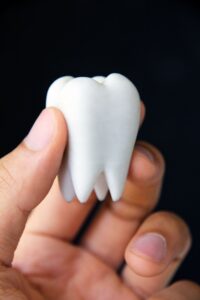
Molars are an important type of teeth in the human dental arch and play a crucial role in the process of mastication. In this article, we will discuss the different types of molars, their structure, function, and other important details. Firstly, let’s talk about the location and number of molars in the human mouth. After the completion of the dental arch, there are 12 molars present in the mouth, with three on each side of the upper and lower jaw. The last molar is known as the “wisdom tooth,” which typically erupts between the ages of 17 and 25. However, not all individuals may develop a wisdom tooth, while some may have them erupt earlier or later than usual. The molars are located at the back of the dental arch, and they have a large, flat surface that is ideal for grinding and chewing. They are designed to handle hard, fibrous, and bulky foods, primarily on the molar ridges, or occlusal surfaces. There are several types of molars, including the first, second, and third molars. The first molars appear around the ages of 6 to 7 years, and they are the largest teeth in the dental arch, with three to four cusps and four to five roots. The second molars erupt between the ages of 12 to 13 years and have four cusps and three roots.The third molars or the wisdom teeth develop in late adolescence, between the ages of 17 and 25, and may or may not erupt through the gum tissue fully. The structure of molars is unique and complex. They have a crown, which is the visible part of the tooth, and the root, which is the part of the tooth embedded within the jawbone. Molars have a larger crown than other teeth and are adapted to withstand the stresses of chewing. Molars have a flat top called the occlusal surface with cuspids.
The occlusal surface has fissures and grooves, which tend to collect food particles and can be difficult to clean properly. Therefore, prevention and early intervention are the most effective strategies to keep molars healthy. Molar teeth are essential for the process of mastication, which involves breaking down food into smaller particles, allowing greater exposure to digestive enzymes. The molar ridges on the occlusal surface of molars grind down food particles, transforming them into a fine paste that enables proper digestion and absorption of nutrients. In summary, molars are a vital component of the human dental arch, located at the back of the dental arch and designed to handle hard, fibrous, and bulky foods. They have a sophisticated and complex structure, including a large crown and several roots. Molars are essential for proper mastication and digestion, and maintaining their health is crucial for overall oral health.
